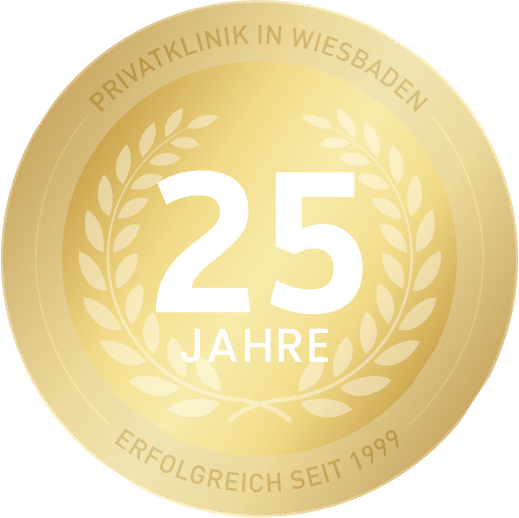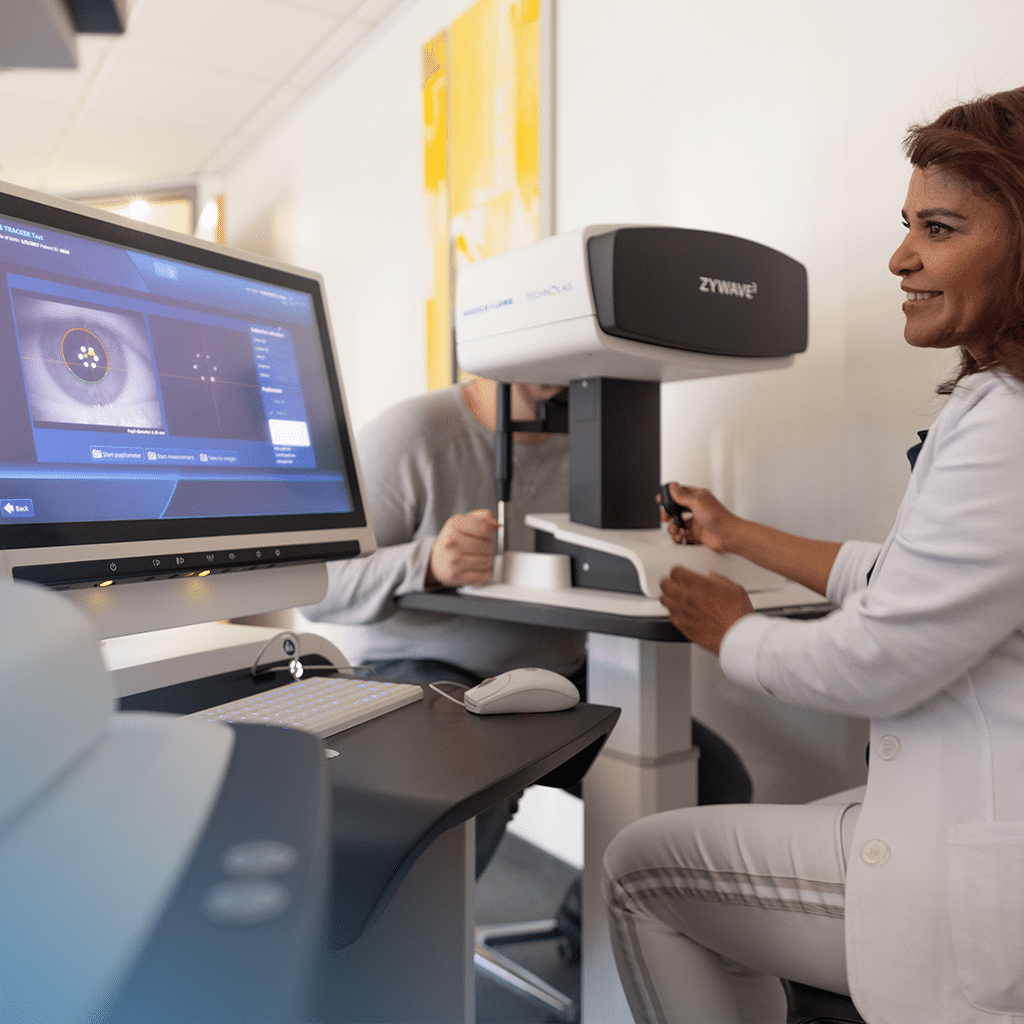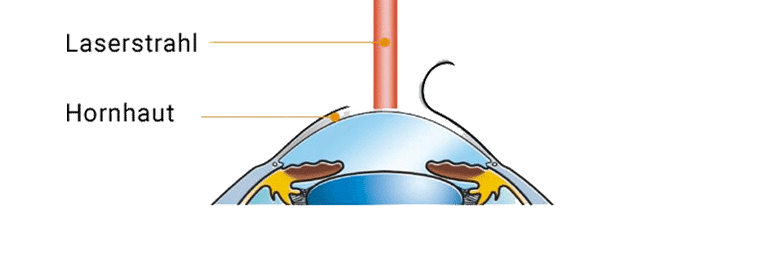Glasses-free from 1000€/eye
Permanent success through laser eye surgery
Do you want a life without glasses or contact lenses? We are here to make this dream come true for you. As your experts for laser eye surgery/LASIK in Wiesbaden, Mainz and Frankfurt, we are at your side with high levels of expertise and many years of experience.

Free initial consultation
Fast appointment scheduling
Mass processing? Not here
Your advantages of our private clinic - our 5-star quality for cataracts
Security ★★★★★
Our exemplary, certified hygiene measures and state-of-the-art technologies offer you a safe environment especially for your cataract treatment. With an impressive track record in cataract surgery We guarantee the highest safety standards and put your well-being first.
Individual advice ★★★★★
We offer comprehensive, tailored to you and your specific needs in the treatment of cataracts tailored advice from our chief physician. Our warm and knowledgeable team creates a fear-free atmosphere and guides the cataract surgery carefully with a local anesthetic.
Quality ★★★★★
Our certifications and advanced technology guarantee outstanding quality and customer satisfaction in all aspects of cataract treatment – we focus on quality rather than quantity in every cataract operation.
competence ★★★★★
As experts for cataracts Our entire team, from the dedicated specialist staff to the renowned chief physician, attaches great importance to the highest level of specialist expertise and offers you a first-class all-round service from diagnosis to detailed aftercare.
Requirements for LASIK treatment
- The prescription should have been stable for at least 1 year.
- The minimum age is 18 years.
- There should be no progressive retinal diseases.
- No procedure should be performed during pregnancy or breastfeeding.
What does LASIK mean?
LASIK (laser in situ keratomileusis) is a laser eye procedure used to correct vision problems. It uses an excimer laser to change the shape of the cornea. The goal is to adjust the eye so that light rays are focused precisely on the retina, resulting in clear vision. LASIK is the popular choice for people who want to reduce their dependence on glasses or contact lenses. The treatment is usually quick, recovery time is short, and it offers a permanent solution to various types of vision problems.
What can be corrected with the LASIK procedure?
The LASIK procedure is an effective method for correcting various visual impairments, but with certain limitations:
Nearsightedness (myopia): LASIK can be successful for myopia up to -10 diopters (dpt).
Farsightedness (hyperopia): In cases of hyperopia, LASIK can be effective up to a degree of +4 dpt.
Astigmatism (curvature of the cornea): LASIK can correct astigmatism up to 6 dpt.
It is important to note that an individual's suitability for LASIK treatment depends on other factors, such as the thickness and shape of the cornea, the specific degree of visual impairment, and overall eye health. An ophthalmologist can determine whether LASIK is the right treatment for an individual through a comprehensive examination using appropriate diagnostic equipment.
5 advantages of the LASIK procedure
1. Painless and time-efficient treatment
The procedure only takes a few minutes and is painless thanks to the local anesthesia.
2. Outpatient implementation
LASIK is usually performed on an outpatient basis, meaning you can go home immediately after the operation.
3. Rapid improvement of vision
You will have good vision after just a few hours. You can largely resume your normal daily life the next day.
4. Gentle and fast healing process
The natural structure of the superficial corneal layers is preserved and the healing process is without complications.
5. Reliable and recognized worldwide
Through LASIK treatment, more than 17 million people worldwide have been operated on with outstanding treatment results and have successfully freed themselves from glasses and contact lenses. This method is considered reliable worldwide and enables an improved quality of life through clear and independent vision.
Alternatives to LASIK
The Trans-PRK and Femto-LASIK are both advanced alternatives to the classic LASIK method. Trans-PRK (transepithelial photorefractive keratectomy) is a non-contact procedure in which the top layer of the cornea is removed with a laser, ideal for patients with thinner corneas. Femto-LASIK, on the other hand, uses a femtosecond laser to create a precise corneal flap and offers rapid healing and high precision, particularly suitable for complex vision defects. Both methods offer innovative, safe alternatives for individual vision correction.
Together with our partners for best quality & your safety
Exclusive treatment and personal care by Dr. Beate Steinhorst
For more than 20 years, Dr. Beate Steinhorst has been working with the utmost personal commitment and expertise to enable people to live a life without glasses. Through advanced eye surgery and unique 5-star care, she helps her patients experience the world in full clarity. With her many years of experience and outstanding expertise, Dr. Steinhorst ensures that each of her patients achieves the best possible quality of vision.
You are currently viewing a placeholder content of YouTube. To access the actual content, click on the button below. Please note that this involves sharing data with third parties.
More informationFemto-LASIK – the gold standard in LZW
Femto-LASIK is considered the gold standard in refractive eye surgery and is known for its exceptional precision in correcting refractive errors such as nearsightedness, farsightedness and astigmatism. This method enables a correction accuracy of up to 1/100 diopter. This method combines the advantages of Femto-LASIK with the advanced technology of the femtosecond laser, which enables a tailor-made, precise treatment for each individual eye.


The way to life without glasses with LASIK.
Every patient, every eye and every individual need is unique. At LZW you benefit from detailed patient-centered advice, supported by one of the most modern excimer lasers and femtosecond lasers. Thanks to the latest LASIK diagnostic software, we achieve unprecedented accuracy in our preliminary examinations.
From a personal suitability check to the preliminary examination, laser eye surgery and follow-up examination – with us you receive an all-round, worry-free package directly in our private clinic in Wiesbaden.
How does LASIK work?

Step 1: Preparation of the corneal disk (flap)
First, a thin slice of the cornea, approximately 0.12 mm thick, is prepared using a computer. This process is carried out with extreme precision to ensure precise control over the thickness and shape of the flap. The flap can be prepared using a keratome or with an additional laser - the FEMTO second laser.

Step 2: Access and modeling of the cornea
After preparation, the corneal disc is carefully folded back like a book cover. This allows access to the underlying deeper layer of the cornea, which is responsible for correcting vision. The corneal layer is then precisely modeled using a specialized laser. The laser specifically removes corneal tissue in order to change the curvature of the cornea according to the necessary vision correction.

Step 3: Repositioning the corneal disc
After the laser treatment, the corneal disc is folded back into its original position. It adheres itself and serves as the body's own plaster, protecting the treated area and supporting the healing process.
Real experiences and results with LASIK
Based on authentic experiences and outstanding results, we are proud to be the best-rated laser eye clinic in Wiesbaden. Our 4,8 Sterne bei Google Reviews speak for themselves. Together we will accompany you, step by step, on the way to a life without glasses.




FAQ: Frequently Asked Questions
How much does LASIK surgery cost?
Do health insurance companies cover the costs?
Costs will be covered by the statutory health insurance Unfortunately, this does not occur without a medical indication.
From private health insurance companies The costs of LASIK are covered in whole or in part. It is advisable to ask the respective health insurance company about the exact conditions and to submit a cost estimate in any case.
Is the laser treatment painful?
Will I be in pain after the laser treatment?
How long does the treatment take?
How long do the results of LASIK laser eye treatment last?
When can I drive, exercise or work again after surgery?
After laser eye surgery, most patients can:
drive a car: After just 1 to 2 days, once visual acuity has stabilized.
Work: Return to work is usually possible after 1-2 days, although the use of eye drops for follow-up treatment during work is important.
to do sports: Sports activities can usually be resumed 1-2 days after treatment. However, direct contact with the cornea and vigorous rubbing of the eyes should be avoided in order not to endanger healing.
These times may vary depending on the individual healing process and type of treatment.
What are the success rates for LASIK, Femto-LASIK or Trans PRK?
According to worldwide statistics, around 97% of patients no longer need visual aids for distance vision after treatment. The result varies from surgeon to surgeon. In addition to the experience of the treating doctor, the technical level of the laser clinic is crucial. Our clinic has one of the most modern laser technologies in the world.
How well can I see after laser treatment?
Are there any risks associated with laser treatment?

